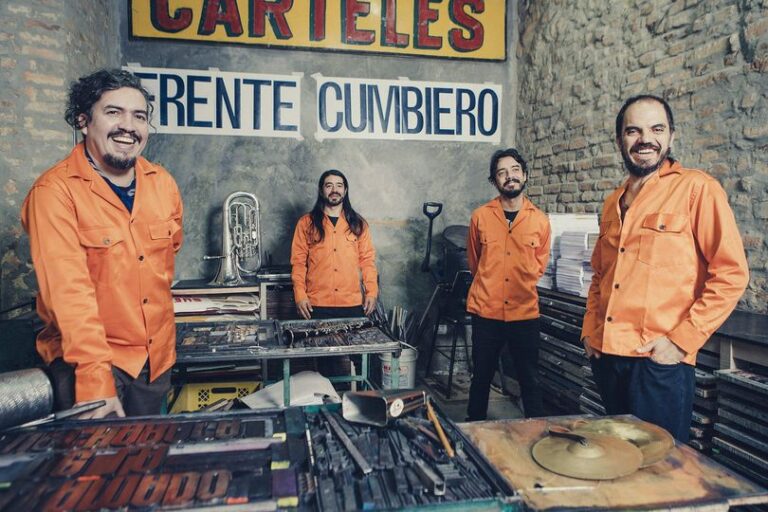Why has cumbia spread throughout Latin America? It’s an Afro-Latin genre that emerged right there, in the Colombian Caribbean. But why — unlike other tropical music such as salsa or merengue — has it been so flexible, being able to adapt to different regions of the continent? From the Colombian roots sound to the psychedelic Peruvian chicha, from the Mexican sonidera wave to the bailantas of the Argentine slums, cumbia became popular everywhere. There’s definitely something about the beat; it’s neither too complex nor too fast, it’s naturally easy-going and infectiously catchy.
Extravagant and irrepressibly danceable, but also restless and experimental, cumbia is the quintessential derivative of Latin American mestizaje, growing far and wide on the continent and blending the modern with the traditional. Cumbia is a pan-regional music with the power to feel local in every place, crossing borders and transforming to give rise to new styles. Today’s cumbia fuses with other music, adapts to different scenes and puts intercultural life into action. A good example of this crossover is Sonido Gallo Negro, the Mexican band that specializes in Peruvian cumbia. They were included in the new outbreak of psychedelic cumbia that we highlighted a couple of years ago. With members coming from surf and garage rock, they came together in 2010 to recreate the sound and inspiration of the 70s.
In tune with Sonido Gallo Negro, we find the Colombian band Frente Cumbiero. Instrumental and also related to psychedelia, they were formed in Bogotá more than a decade ago as a result of the explorations of music lover Mario Galeano. With the mission of bringing cumbia to every stage on the planet, so that other music could benefit from its richness, Galeano has produced alongside dub master Mad Professor and has collaborated with the Japanese band Minyo Crusaders. A natural devotee of tropical music, he has two other projects that we cannot omit: the cumbia trio Los Pirañas and the super collective Ondatrópica assembled with the British DJ Quantic.
In the late 90s, Mario Galeano formed Ensamble Polifónico Vallenato together with two other Colombian psychedelic figureheads, Eblis Álvarez (Meridian Brothers) and Pedro Ojeda (Romperayo, Los Pirañas). Since then, and especially with his Frente Cumbiero, he has been largely responsible for the new rise of popular music in his country. “The fact that we continue making music […] is a very faithful demonstration of our commitment to music, to sound, to cumbia and to Latin America,” he told the Mexican edition of Vogue at the end of 2020, to celebrate the release of Cera Perdida. “The mass media is fixated on commercial paths and shows other things,” Mario argued. “We’ve always been in a resistance angle closely linked to the underground or niche scenes in Bogotá, playing in small bars, but always with a base of people who support us. One of the most important things for us is to connect outside Colombia’s borders and reach the countries of Latin America and beyond.” (See Frente Cumbiero live in Miami on Friday, September 6th. Take advantage of buy two, get two free tickets.)
Willing to renew Latin American cumbia by fusing it with other genres, from bolero to rock, passing through ska and reggae, we find bands such as the Mexicans Son Rompe Pera and the Chileans Chico Trujillo. Hailing from Naucalpan de Juárez, one of the suburbs surrounding Mexico City, the Gama brothers lead this project that keeps their family’s legacy of marimba music alive. With cumbia as its foundation, Son Rompe Pera tackles folkloric traditions and neighborhood themes with a wild psychobilly attitude. Their two albums, Batuco (2020) and Chimborazo (2023), were released by AYA Records, a sub-label of ZZK Records. Friendship and beers during tours gave rise to Chico Trujillo, the spearhead of the so-called new Chilean cumbia and one of the many projects involving singer-songwriter Aldo “El Macha” Asenjo, also frontman of La Floripondio and Bloque Depresivo.
Not far from there are the Kumbia Queers, a band of Argentine women trained in the punk school and proud of their LGBT motto. The country of Messi, by the way, has given rise to different cumbia expressions. There are subgenres such as cumbia santafesina, native to the province of Santa Fe, with the influence of regional music such as chamamé and bands that have been playing since the 80s such as Los Del Fuego and Los Palmeras. Other styles have emerged from the slums on the outskirts of Buenos Aires, such as cumbia villera, with essential references such as Pablo Lescano and his historic band Damas Gratis, which has been a hit in dance halls called bailantas since the beginning of 2000.
Buenos Aires is also home to ZZK Records, the Latin American electronic music label that began by giving recognition to the new sounds of digital cumbia. The fusion of cumbia and electronica was a boom, and even has its predecessors in Peru: the singer-songwriter Rossy War gained fame in the 90s for making tecnocumbia. The journey seems to have no end: Argentina also welcomed the migratory waves of Peruvian cumbia that same decade of the 90s, through bands such as Grupo Karicia and Grupo Ciclón. Of course, if we talk about Peru, we have to talk about the psychedelic revolutions that emerged in the late 60s and gave birth to Amazonian cumbia (Los Mirlos, Juaneco y su Combo) and Andean cumbia (Los Shapis, Chacalón y La Nueva Crema). Direct heirs of chicha, current tropical music bands such as Bareto, Barrio Calavera, Olaya Sound System and La Nueva Invasión join from Lima.


